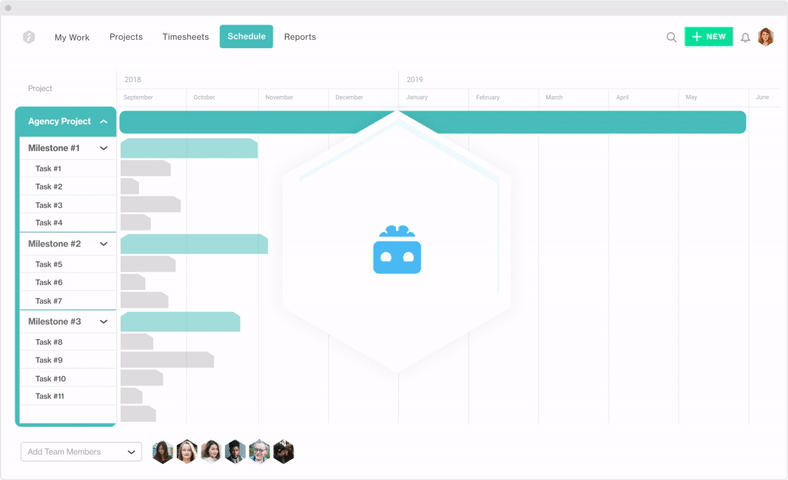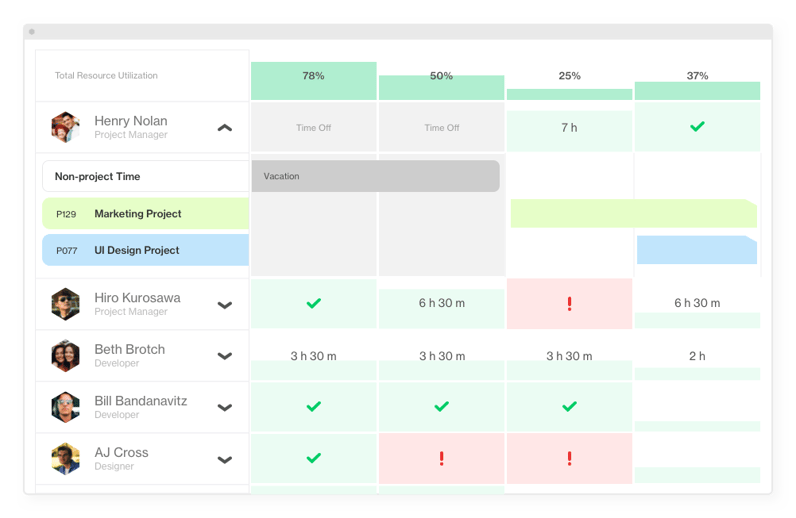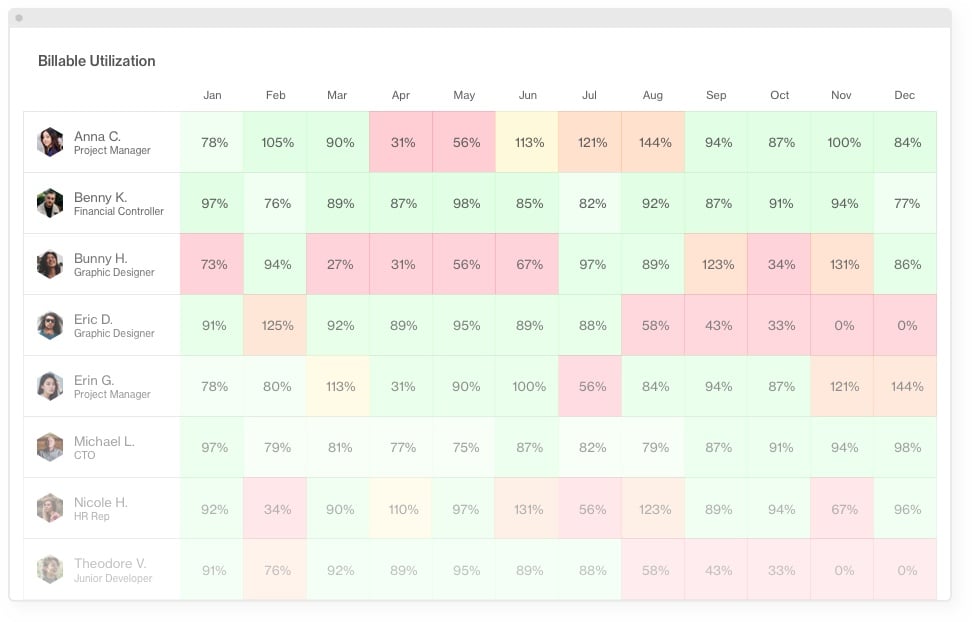What an Effective Capacity Planning Process Looks Like in 2023

Companies not leveraging capacity planning are at a severe disadvantage. They not only lack understanding if they can meet demand, but also have a shortsighted view on their opportunities to improve efficiency.
Overscheduled people, ad-hoc tasks piling up, conflicting priorities, complaining customers - can all be the results of poor capacity planning. There is of course another side of the coin - employees sitting on a bench, which often happens in consulting firms, or underutilized teams, providing less value than intended.
Overlooking the importance of capacity planning in the operations process can very quickly affect the quality of services you provide as a company, and who would want that? We’ve made this guide so you could become better at capacity planning and never find yourself at the end of the two above-mentioned extremes.
- What is capacity planning?
- The value of capacity planning
- Capacity planning tools & best practices
- Common capacity planning mistakes
- How to forecast resource demand
What is capacity planning?
To define capacity planning, let’s first look at the very meaning of capacity in terms of project management. Typically, capacity is the maximum of what you can take and accomplish within the perimeter of a normal working schedule.
In turn, capacity planning is a process that identifies whether or not you have the resources and skills to do the work, or the supply to meet the demand. In contrast to resource planning, capacity planning looks at the organizational level to forecast and ensure that businesses can keep up with customer needs.
The very purpose of capacity planning and capacity management in general in a service business is to make sure you’re using resources efficiently, so it should answer the following questions:
- Does your company have the bandwidth for new projects?
- What skill sets are the most important, but missing from your resource pool?
- When do I need to hire new people?
- How can capacity be optimized to deliver better results?
- Is every resource assigned to the right job?
The value of capacity planning
Capacity-based planning has numerous benefits.
1. Gets you in front of problems
Having a radar on your teams’ capacity can prevent scope creep and ensure that you meet the delivery date. It spares you the unfortunate risk of going over budget, at the same time allowing you to predict what can be accomplished in a certain time frame. Being able to say how much capacity you have is being able to predict what can be done.
2. Backs up hiring decisions with concrete data
Capacity planning, as no other process, informs hiring decisions, allowing you to shore up the gaps in the skill sets. It can help executives understand what drives the hiring process by highlighting inadequate skills.
3. Eliminates waste along value streams
Not serviced correctly, some projects may either lack capacity or have too much assigned to them. Armed with the knowledge of where resources spend their time, you can optimize project processes, cut down on time wasted, or vice versa, assign new people to the project team.
4. Enhances transparency and accountability
Transparency is key to a successful work environment and employee morale. Capacity planning fosters transparency indicating, once again, how much capacity everyone has to contribute to the process.
Capacity planning tools & best practices
Capacity planning is a process of determining resources, and when implemented correctly, it gives you heads up about resource shortages in advance. To succeed with capacity planning, you must understand two concepts from the beginning: bottlenecks and critical paths.
A bottleneck is something or someone that impedes the flow of your resources and blocks everyone from doing the planned work. It reduces the capacity of the overall process by clogging up the project and is therefore important to address before it turns into a disaster.
Bottlenecks often appear when there are dependencies and resolving those is key to improving productivity. Too many bottlenecks on a constant basis could mean that there’s a shortage of resources and serve as a wake-up call that to meet demand, you simply need to add capacity.
Bottlenecks can be spotted on your Kanban board, or a resource schedule, if you have one.
Pro tip: To spot bottlenecks easily, you could also add a ‘Blocked’ column to your Kanban board. It would showcase tasks with a dependency and communicate what hinders the flow.
Another way that helps to plan capacity is mapping out a critical path for the project. A critical path is the longest chain of activities that go into the project and must be finished by the due date. It includes all milestones, tasks, dependencies and their duration. The most common way to visualize it is by using a Gantt chart.
Once determined, a critical path would give you an airplane view of dependencies, uncover how processes tangle in your projects, and indicate if you can finish the project with available resources. It can also reveal which activities can be compressed to finish the project faster.
Pro tip: Plan with Forecast's Auto Schedule to predict the realistic end date of the project and balance your team's workloads.
Common capacity planning mistakes
It shouldn’t come as a surprise, but capacity planning comes with many challenges. A widespread and costly mistake companies commit way too often is overestimating an employee’s availability, in other words, overbooking their resources with work their schedules can’t fit in.
Throwing too much work on your resources’ shoulder (to the extent that it exceeds their ability to deliver) can be a direct result of not understanding your bandwidth in real time. The reason behind this is using old ways of doing resource capacity planning and time tracking. Namely, Excel and spreadsheets.
To solve the problem of constrained capacity, you will need an overview of the entire resource pool that would allow you to monitor everyone’s allocation and be in perfect sync with your projects and timesheets. Aim for the view like this:

To understand how much capacity is available in the near future, you'd need a better overview of your team's allocations, vacation time, and utilization rates. All of these functionalities are covered in Forecast's Schedule.
Another common capacity planning mistake is a mismatch between skill sets and projects. It’s important to remember that capacity planning is not allocating resources by virtue of situations, or “smoothing” the workloads. Capacity planning, at its best, is finding and assigning people with the right skills to the right projects. Otherwise, the bottom line may suffer.
When you ask consultants why they leave their jobs, you might pretty well hear that resource management is not the strongest side of consulting firms, as people are often assigned only based on their availability. This scenario, on a broader scale, leads to disengaged employees.
You might as well consider the level of seniority. When senior software engineers are assigned to projects and tasks that could be completed by junior engineers, it not only costs you more money, but also frustrates the assignee. A report showing how profitable each role is could shed some light on where the adjustments could be made.
How to forecast resource demand
Predicting future resource requirements is a significant part of capacity planning, but here's one hack on how to understand where the demand is the highest. Your utilization report. Employees that have record-breaking utilization rates are profit-making and very much in demand. That's why calculating resource utilization is so important is service-based companies - by showing the percent of billable hours, it can give you a clue which services are in the request.
Whenever there are expected shortages of resource capacity in your company, utilization will be at its peak and vice versa on your report:

Forecast has just released the new Utilization report that provides a full picture of your team's billable and resource utilization rates now and months in advance across the entire organization, including overtime, available time, performance, and more. You can filter people by department, projects, roles, and teams.
It’s not news that here in Forecast, we think capacity planning is extremely important for the success of any service company, so we've built resource management tools in a connected platform to make this complicated process more accurate. Forecast gives you a real-time overview of your resources and caters to the need to plan capacity months ahead. Book a demo to see how it could help in your situation.
You might like to read these articles on our blog..
Subscribe to the Forecast Newsletter
Get a monthly roundup of productivity tips & hacks delivered straight to your inbox
